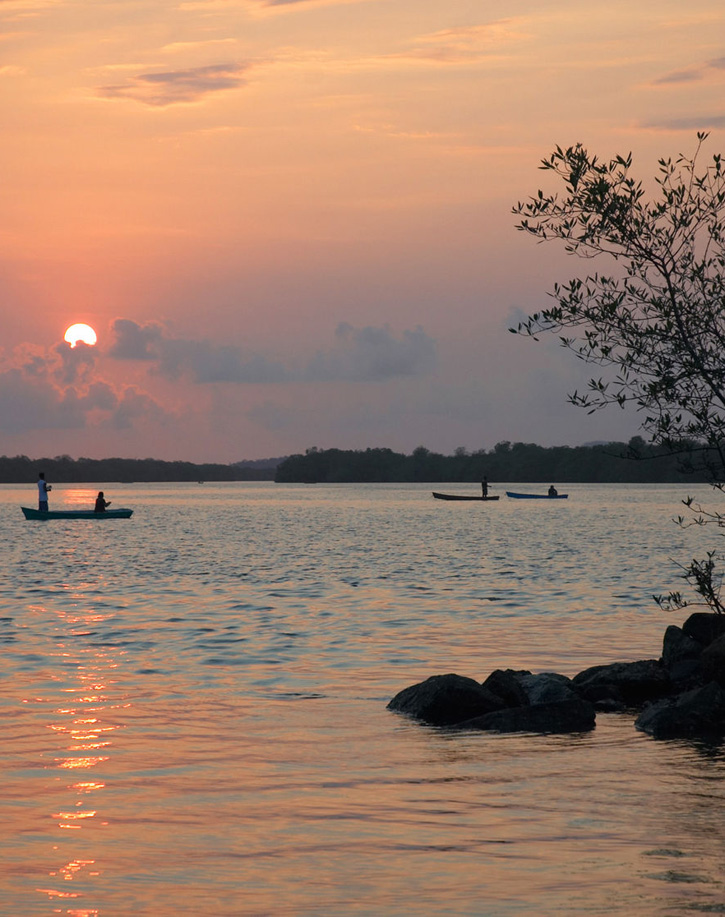
Parque Nacional Lagunas de Chacahua. Photo © Elisa Locci/123rf.
For most visitors, mainly Mexican families on Sunday outings, access is by boat, except for one unpaved road (passable in the dry season; marginally so in the wet). The boats go from east-side Zapotalito village, where the local fishing cooperative offers full- and half-day excursions to the beaches: Playa Hermosa on the east side and Playa Chacahua on the west.
Zapotalito, on the eastern shore of Laguna Pastoría, is the busiest quick access point to the Lagunas de Chacahua. Get there from the Zapotalito turnoff at Kilometer 82, 82 kilometers (51 mi) from Pinotepa and 65 kilometers (41 mi) from Puerto Escondido. (Taxis and local buses run from Río Grande all the way to Zapotalito on the lagoon, while second-class buses from Puerto Escondido and Pinotepa Nacional will drop you on the highway.)
From the Zapotalito landing, the fishing cooperative, Sociedad Cooperativa Turística Escondida, enjoys a near-monopoly for transporting visitors on the lagoons. The boat workers used to make their living by fishing; now they mostly ferry tourists. Having specialized in hauling in fish, most are neither wildlife sensitive nor wildlife knowledgeable. Canopied powerboats, seating about 10, make long, full-day round-trips across the lagoon to lovely Playa Chacahua and village ($110/boat for 10 people, $70/boat for 5). It’s best to arrive before 11am. Cheaper half-day excursions (about $30) take visitors to nearby Playa Cerro Hermosa at the mouth of Laguna Pastoría for a couple of hours’ beach play and snorkeling (bring your own snorkeling gear).
(Note: There are two Chacahua villages, on opposite—east and west—sides of Laguna Chacahua. To distinguish them, they are referenced here as east-Chacahua and west-Chacahua, respectively.)
The Cocodrilario Chacahua is a crocodile hatchery at west-Chacahua village, on the west shore of Chacahua lagoon. It’s also home to a small community of costeño families, a run-down hotel, a few stores, and some lagoonside palapa restaurants. Past the rickety crocodile caretaker’s quarters are a few enclosures housing about 100 crocodiles segregated according to size, from hatchlings to six-foot-long toothy green adults. They’re worth seeing while you’re at west-Chacahua; ask your boat driver to stop there for 10 minutes or so.
The more expensive, but quick, full-day private excursion to Playa Chacahua, about 23 kilometers (14 mi) away, unfortunately necessitates a fast trip across the lagoon. It’s difficult to get the boat operators to slow down. They roar across broad Laguna Pastoría, scattering flocks of birds ahead of them. They wind among the islands, with names such as Escorpión (Scorpion), Venados (Deer), and Pinuelas (Little Pines), sometimes slowing to view multitudes of nesting pelicans, herons, and cormorants. They pick up speed again in the narrow jungle channel between the lagoons, roaring past idyllic, somnolent El Corral village, and break into open water again on Laguna Chacahua.
The excursion climaxes at the east-lagoon half of Chacahua village across Laguna Chacahua. The main attraction here is Playa Chacahua, lovely because of its isolation. The unlittered golden-white sand, washed by gently rolling waves, seems perfect for a host of beach diversions. You can snorkel off the rocks nearby, fish in the breakers, and surf the intermediate breaks that angle in on the west side. During big swells, when the sand bars on the bottom are in the right position, the surf here can be spectacular, with long right-breaking waves. Once only a few, now several palapas crowd the beach, offering food, drinks, and lodging.
The original and still most popular lodging here is the Restaurant and Hotel Siete Mares (Seven Seas, tel. 954/114-0062, $25 d). The 13 cabañas occupy Chacahua’s choicest location. Half of them face the beach, while the other half face the lagoon. For more privacy and tranquility, choose the latter. Rooms come with a fan and private shower and toilet. The Siete Mares’s added bonus is friendly owner Doña Meche’s restaurant (8am-9pm daily, $3-8), which keeps satisfied customers returning year after year.
Furthermore, Doña Meche’s daughter Juana also rents cabañas. You’ll find them about 100 yards from the beach, as you walk north along the lagoon-front. Juana is proud of her 17 semi-deluxe Cabañas Delfines (tel. 954/132-8054, $23 d with fan, shower-bath, and toilet, $35 d with a/c added, camping $5 pp per night). She also welcomes tenters to her campground, including hammock-hung palapa shelters and showers.
If these accommodations are full, you can also take a look at El Piojo cabañas (on the beach, tel. 954/559-5073) and those of Isabel Ortíz (on the beach, tel. 954/588-6656).
Also, some groceries and fruits and vegetable are available at Abarrotes Nayeli (8am-9pm daily), on the lagoonfront, between Juana’s and Reynaldo’s cabañas.
Excerpted from the Seventh Edition of Moon Oaxaca.